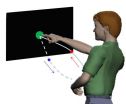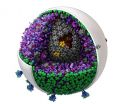(Press-News.org) INDIANAPOLIS and NEW BRUNSWICK, N.J. -- Imperceptible variations in movement patterns among individuals with autism spectrum disorder are important indicators of the severity of the disorder in children and adults, according to a report presented at the 2014 Society for Neuroscience annual meeting in November.
For the first time, researchers at Indiana University and Rutgers University report developing a quantitative way to assess these otherwise ignored variations in movement and link those variations to a diagnosis.
"This is the first time we have been able to explicitly characterize subtypes of severity in autism spectrum disorder," said Jorge V. José, Ph.D., vice president of research at Indiana University and the James H. Rudy Professor of Physics in the IU Bloomington College of Arts and Sciences. "We also have determined that a pattern exists in the movement variations in some cases between children with autism and their parents, leading us to surmise that genetics plays a role in movement patterns."
In a blinded study, José, who also is a professor of cellular and integrative physiology at the IU School of Medicine, and co-principal investigator Elizabeth B. Torres, Ph.D., an assistant professor in the Department of Psychology in the School of Arts and Sciences at Rutgers University, attached high-sensitivity movement sensors to the arms of study participants to track their micro-movements as they extended and retracted their hand to touch a specific spot on a touch screen.
Using analytics they developed, Drs. José and Torres, together with Di Wu, a Ph.D. graduate student in José's lab in the physics department at IU Bloomington, evaluated the local spikes in speed -- traditionally considered as noise in the data. The sensors recorded 240 movements per second for the 30 people with autism, eight healthy adults and 21 parents of children with autism tested. The participants were asked to touch a spot on a screen moving continuously about 100 consecutive times.
"These variations in the hand's movement speed produced a pattern that clustered in specific regions of a graph that produced metrics we could use -- not only in children with autism but in their parents," Dr. Torres said. "People with autism are known to have problems with sensing their body motions and of their body in general. Our earlier research proved that the random patterns of their speed were significant. What we did not expect was to find random, minute speed fluctuations during the intentional action itself, much less identify this form of intentional tremor in some of their parents."
That finding was part of the report presented by Wu at the 2014 Society for Neuroscience meeting in November attended by more than 32,000 scientists.
"In healthy adults, the minute fluctuations in the speed of their movements, which we call peripheral spikes or p-spikes, normally occur at the onset or at the end of the arm extension exercise," Wu said. "They show very few p-spikes during the actual action, as the hand speeds up or slows down en route to the target. However, healthy children in the 3-to-5-year-old range have random patterns of p-spikes, as do adults and children with autism spectrum disorder."
What this suggests, the researchers said, is that p-spikes normally become more organized with age in typically developing individuals. But, in children and adults with autism, the p-spikes remained random. The researchers tested people with autism between the ages of 3 and 30 and identified an absence of transition that typically developing children undergo after 4 or 5 years of age.
The researchers also tested 14 mothers and seven fathers who have a child with autism. When evaluating the noise from the data produced from the parents, the researchers were surprised to find that some of the parents had random p-spikes clustering in the graph similar to that of their children.
"This finding suggests that genetics may play a role in p-spike patterns," Wu said. "We will need to further explore this result in other populations with neurodevelopmental disorders of known genetic origins and their family to better understand the surprising findings."
Drs. José and Torres said the p-spike patterns are useful in determining severity of the disorder.
"Normally, children get more coordinated as they age, but we found that the young children with autism and the adults with autism all produced random p-spikes showing that they do not transition as they develop," Dr. José said. "We also found a correlation between the randomness of the p-spikes and the severity of the autism disorder. Among those with autism, the more random their p-spikes, the lower spoken language ability they had overall."
This research was funded by National Science Foundation Cyber-Enabled Discovery and Innovation Type I (Idea), grant number 0941587 -- "A novel quantitative framework to study lack of social interactions in Autism Spectrum Disorders" -- and by the New Jersey Governor's Council for Medical Research and Treatment of Autism, grant number CAUT14APL018 -- "New objective autism inventory to quantify peripheral plasticity during standard ADOS-2 social exchange."
INFORMATION:
Two years ago, researchers at the U.S. Department of Energy's Joint BioEnergy Institute (JBEI) engineered Escherichia coli (E. coli) bacteria to convert glucose into significant quantities of methyl ketones, a class of chemical compounds primarily used for fragrances and flavors, but highly promising as clean, green and renewable blending agents for diesel fuel. Now, after further genetic modifications, they have managed to dramatically boost the E.coli's methyl ketone production 160-fold.
"We're encouraged that we could make such a large improvement in methyl ketone ...
In a remarkable collaborative effort between human and veterinary clinicians, a 29-year-old bottlenose dolphin recently underwent therapeutic bronchoscopy to treat airway narrowing, or stenosis, that was interfering with her breathing. The dolphin, a therapy animal for mentally and physically challenged children at Island Dolphin Care in Key Largo, Florida, is doing well one year after the procedure.
"Many of the medical treatments and procedures used in humans were developed and tested in animals, and many are used in the care of both," said lead author Andrew R. Haas, ...
MADISON, Wis. -- In 1997, IBM's Deep Blue computer beat chess wizard Garry Kasparov. This year, a computer system developed at the University of Wisconsin-Madison equaled or bested scientists at the complex task of extracting data from scientific publications and placing it in a database that catalogs the results of tens of thousands of individual studies.
"We demonstrated that the system was no worse than people on all the things we measured, and it was better in some categories," says Christopher Ré, who guided the software development for a project while a UW ...
MADISON, Wis. -- If Brad Singer knew for sure what was happening three miles under an odd-shaped lake in the Andes, he might be less eager to spend a good part of his career investigating a volcanic field that has erupted 36 times during the last 25,000 years. As he leads a large scientific team exploring a region in the Andes called Laguna del Maule, Singer hopes the area remains quiet.
But the primary reason to expend so much effort on this area boils down to one fact: The rate of uplift is among the highest ever observed by satellite measurement for a volcano that ...
ANN ARBOR--As much as two-thirds of Earth's carbon may be hidden in the inner core, making it the planet's largest carbon reservoir, according to a new model that even its backers acknowledge is "provocative and speculative."
In a paper scheduled for online publication in the Proceedings of the National Academy of Sciences this week, University of Michigan researchers and their colleagues suggest that iron carbide, Fe7C3, provides a good match for the density and sound velocities of Earth's inner core under the relevant conditions.
The model, if correct, could help ...
LA JOLLA, CA - December 1, 2014 - Researchers can now explore viruses, bacteria and components of the human body in more detail than ever before with software developed at The Scripps Research Institute (TSRI).
In a study published December 1 in the journal Nature Methods, the researchers demonstrated how the software, called cellPACK, can be used to model viruses such as HIV.
"We hope to ultimately increase scientists' ability to target any disease," said Art Olson, professor and Anderson Research Chair at TSRI who is senior author of the new study.
Putting cellPACK ...
MADISON, Wis. - In 1997, IBM's Deep Blue computer beat chess wizard Gary Kasparov. This year, a computer system developed at the University of Wisconsin-Madison achieved something far more complex. It equaled or bested scientists at the complex task of extracting data from scientific publications and placing it in a database that catalogs the results of tens of thousands of individual studies.
"We demonstrated that the system was no worse than people on all the things we measured, and it was better in some categories," says Christopher Ré, who guided the software ...
LEXINGTON, KY. (Dec. 1, 2014) -- A group of physiologists led by University of Kentucky's Tim McClintock have identified the receptors activated by two odors using a new method that tracks responses to smells in live mice.
Their research was published in the latest edition of The Journal of Neuroscience.
Using a fluorescent protein to mark nerve cells activated by odors, McClintock and his coworkers identified the receptors that allow mouse nerve cells to respond to two odors: eugenol, which is a component of several spices, most notably cloves, and muscone, known ...
When people hear about the dangers of the ozone hole, they often think of sunburns and associated health risks, but new research shows that ozone depletion changes atmospheric and oceanic circulation with potentially devastating effects on weather in the Southern Hemisphere weather.
These could include increased incidence of extreme events, resulting in costly floods, drought, wildfires, and serious environmental damage. The ecosystem impacts documented so far include changes to growth rates of South American and New Zealand trees, decreased growth of Antarctic mosses, ...
Inundation of nitrogen into the atmosphere and terrestrial environments, through fossil fuel combustion and extensive fertilization, has risen tenfold since preindustrial times according to research published in Global Biogeochemical Cycles. Excess nitrogen can infiltrate water tables and can trigger extensive algal blooms that deplete aquatic environments of oxygen, among other damaging effects.
Although scientists have extensively studied the effects of excess nitrogen in terrestrial habitats, the effect on the open ocean remains unknown. Altieri et al. point out that ...


